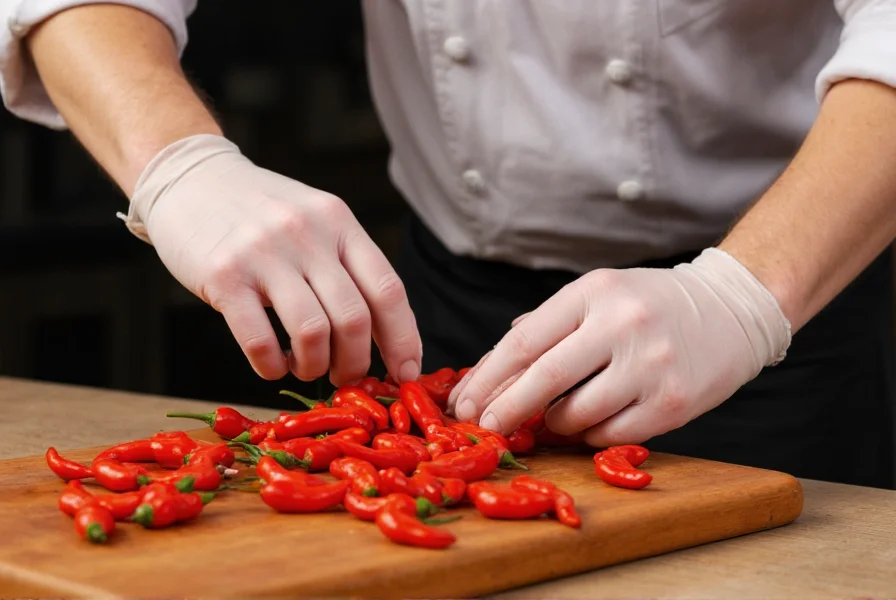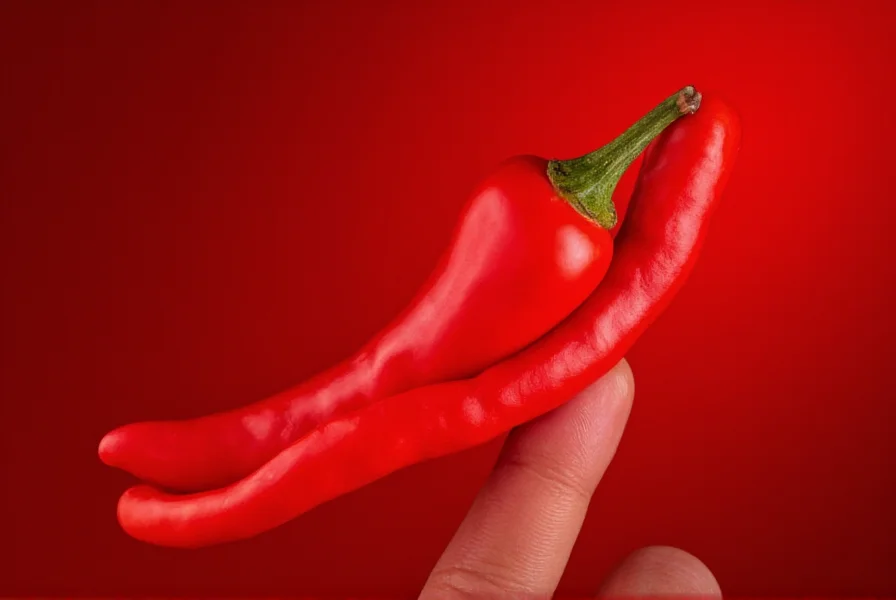Experiencing chili finger is a surprisingly common issue for home cooks and professional chefs alike. When you handle hot peppers, the capsaicin—a hydrophobic, oil-soluble compound—transfers to your skin, binding to pain receptors and creating that familiar burning sensation. Unlike many irritants, water won't help and may actually spread the capsaicin further. Understanding the science behind this reaction is the first step to effective treatment and prevention.
The Science Behind Capsaicin's Burning Effect
Capsaicin works by binding to TRPV1 receptors in your skin—receptors that normally respond to heat and pain. When capsaicin attaches to these receptors, it tricks your nervous system into thinking your skin is burning, even though no actual thermal damage is occurring. This explains why the burning sensation from chili peppers feels so intense and persistent.
Because capsaicin is oil-based rather than water-soluble, it doesn't wash away with water alone. This hydrophobic nature is why the burning sensation lingers long after handling peppers. The compound can remain active on surfaces for days if not properly cleaned, which is why proper cleanup after working with hot peppers is crucial.
Common Causes of Chili Finger
Chili finger typically occurs in these situations:
- Handling hot peppers without gloves during food preparation
- Touching your face, eyes, or other sensitive areas after handling peppers
- Using contaminated kitchen tools or surfaces
- Preparing extremely hot varieties like ghost peppers, scorpion peppers, or Carolina reapers
- Not properly washing hands after handling peppers
Effective Treatment for Chili Burn on Skin
When you get chili pepper on your fingers, immediate action can significantly reduce discomfort. Here are the most effective treatment methods:
| Treatment Method | How It Works | Effectiveness |
|---|---|---|
| Fat-based solutions (oil, milk, yogurt) | Dissolves the oil-soluble capsaicin | ★★★★☆ (Most effective) |
| Alcohol-based solutions | Breaks down capsaicin molecules | ★★★☆☆ (Moderately effective) |
| Vinegar or acidic solutions | Neutralizes alkaline properties of capsaicin | ★★☆☆☆ (Somewhat effective) |
| Water alone | Spreads rather than removes capsaicin | ★☆☆☆☆ (Ineffective) |
Fat-Based Remedies (Most Effective)
Since capsaicin is oil-soluble, fat-based solutions work best for removing it from skin. Immediately after exposure:
- Wash hands with soap and warm water to remove surface residue
- Apply vegetable oil, olive oil, or coconut oil and rub gently
- Rinse with warm water
- Follow with milk, yogurt, or sour cream which contain casein that helps break down capsaicin
- Repeat if necessary until burning subsides
Alcohol-Based Solutions
High-proof alcohol (like rubbing alcohol or vodka) can help break down capsaicin. Soak a cotton ball in alcohol and gently wipe affected areas. Follow with a moisturizer as alcohol can dry skin.
Prevention Strategies for Kitchen Safety
Preventing chili finger is always better than treating it. Implement these kitchen practices:
Protective Gear
Wear nitrile or latex gloves when handling hot peppers. Regular kitchen gloves may not provide sufficient protection as capsaicin can sometimes penetrate thin materials. Change gloves between handling different pepper varieties to prevent cross-contamination.
Proper Kitchen Technique
- Designate specific cutting boards for hot peppers
- Clean all surfaces with soapy water after preparing peppers
- Avoid touching your face while cooking with peppers
- Wash hands thoroughly with soap and warm water before removing gloves
- Consider using kitchen tools instead of fingers to handle peppers

When Home Remedies Aren't Enough
While most cases of chili finger resolve with home treatment, seek medical attention if:
- Burning persists for more than 24 hours despite proper treatment
- You experience severe pain, swelling, or blistering
- Capsaicin has contacted eyes or other sensitive mucous membranes
- You have pre-existing skin conditions that worsen the reaction
Medical professionals may prescribe topical treatments containing lidocaine or other numbing agents to provide relief when home remedies fail.
Special Considerations for Sensitive Skin
People with sensitive skin, eczema, or other dermatological conditions may experience more severe reactions to capsaicin. If you have sensitive skin:
- Always wear gloves when handling any chili peppers
- Consider using disposable utensils for pepper preparation
- Apply a barrier cream before cooking with peppers
- Have treatment solutions ready before you begin cooking
Myth vs. Fact: Common Misconceptions About Chili Finger
Several myths persist about treating chili burns. Here's what's actually true:
- Myth: Milk neutralizes capsaicin
Fact: Milk's casein protein helps break down capsaicin, but it doesn't neutralize it completely. Full-fat dairy works best. - Myth: Water will wash away the burning sensation
Fact: Water spreads capsaicin since it's oil-based. Use fats or alcohol instead. - Myth: All chili peppers cause the same level of burn
Fact: Burn intensity varies dramatically by pepper variety, from mild bell peppers (0 SHU) to Carolina reapers (2.2 million SHU).
Long-Term Effects and Recovery Timeline
Most chili finger incidents resolve within 4-24 hours with proper treatment. The burning sensation typically follows this timeline:
- 0-15 minutes: Intense burning begins immediately upon contact
- 15-60 minutes: Peak intensity as capsaicin fully binds to receptors
- 1-4 hours: Gradual reduction with proper treatment
- 4-24 hours: Complete resolution for most cases
Without proper treatment, symptoms can persist for several days, especially if capsaicin has transferred to multiple areas of the body.
Frequently Asked Questions
What is the fastest way to stop chili burn on fingers?
The fastest relief comes from applying a fat-based solution like vegetable oil, followed by full-fat dairy products. Rub oil on the affected area for 30 seconds, then rinse and apply milk or yogurt. This dissolves the oil-soluble capsaicin more effectively than water alone.
Why does water make chili burn worse?
Water spreads capsaicin because it's oil-based and hydrophobic. When you use water, you're essentially washing the capsaicin across a larger surface area of skin rather than removing it, which intensifies and prolongs the burning sensation.
Can chili pepper burn cause permanent damage to skin?
No, chili pepper burn typically doesn't cause permanent skin damage. The burning sensation comes from capsaicin activating pain receptors, not from actual tissue damage. However, severe reactions or repeated exposure could potentially cause temporary skin irritation or dermatitis in sensitive individuals.
How can I prevent getting chili on my fingers when cooking?
Wear nitrile gloves when handling hot peppers, use dedicated cutting boards for spicy ingredients, avoid touching your face while cooking, and wash all surfaces thoroughly after preparation. Consider using kitchen tools instead of fingers to handle peppers directly.
Does the heat level of peppers affect how bad chili finger will be?
Yes, significantly. Mild peppers like poblanos may cause minimal discomfort, while super-hots like ghost peppers or Carolina reapers can cause intense, long-lasting burns. The Scoville Heat Unit (SHU) rating directly correlates with potential discomfort—higher SHU means more capsaicin and potentially worse chili finger.











 浙公网安备
33010002000092号
浙公网安备
33010002000092号 浙B2-20120091-4
浙B2-20120091-4